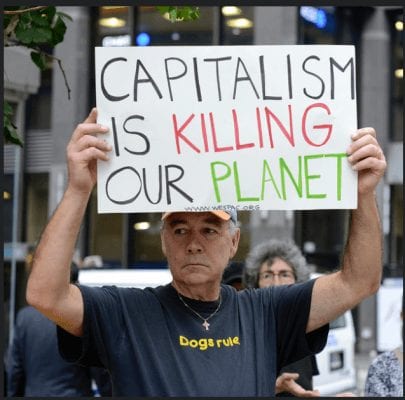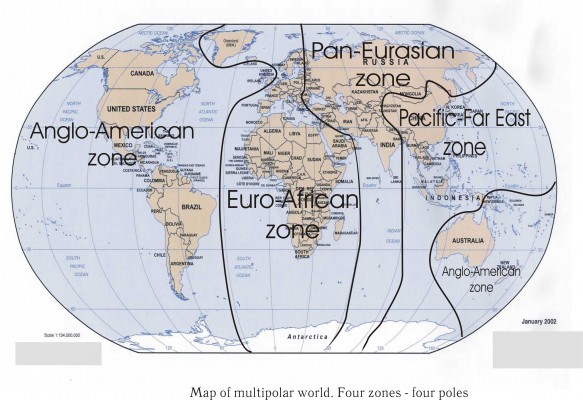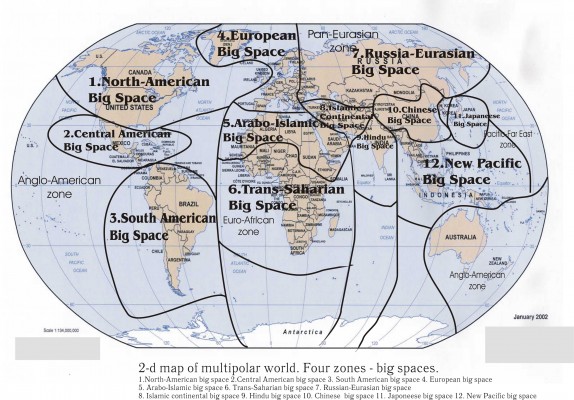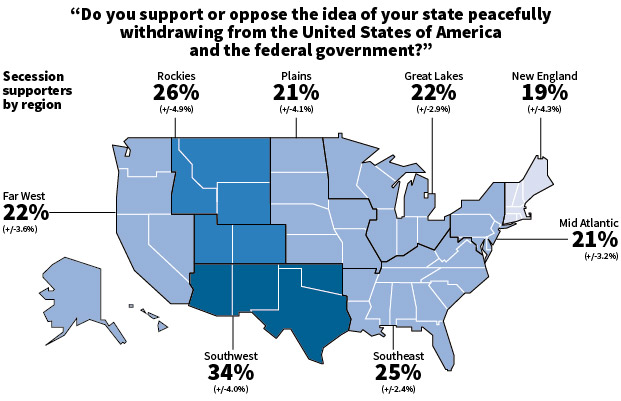SPECIAL FOR THE GREANVILLE POST
“The eventual obsolescence of ‘old media’ and its continual replacement with ‘new media’ is one of the driving forces of change, which sees an end to the hitherto success of the hegemonic myth of a mono-culture, within the present-day borders of the US…”
As the undisputed citadel of global capitalism, changes in the US will affect the entire planet.
By Joaquin Flores
[dropcap]T[/dropcap]he emerging debate over the potential and application for a Fourth Political Theory (4PT) in the United States is one of increasing concern and importance within the present world-crisis. In order for its potential and application to be understood, it must begin by addressing the following areas which contain questions in the form of both problems and possibilities.In this piece we will explore the following five elements. First, an introduction to a way of looking at the problems and possibilities. Second, we will look at some of the material factors which indicate a crisis of legitimacy in the current US regime. Third, we will move on to a description of the elements of an organic process of developing a 4PT intellectual movement that comes from within the US. Fourth, we will look at some of the basic elements which frame the present discourse in the US. Finally, we will provide an understanding of popular political views in the US as being primarily Socialist and Libertarian.
An Interesting Conundrum
From the outset, we encounter what appears to be a very interesting conundrum. On the one hand, the US is the core of the Atlanticist Empire, and as such it enjoys rigid control over media, academia, and—through its coercive mechanisms—the political life of the whole entity. On the other hand, a strong component of the ‘American’ mentality is a rejection of rigidity and frozen concepts, a flexibility and a willingness to experiment with new things, and even to take on new identities. This kind of flexibility and rejection of frozen concepts creates an extraordinary playing field, and will figure into both promises and dilemmas which will face the deconstruction of the US Empire. To understand it then, is to approach questions surrounding the scope of said possibilities.
One manner of approaching these questions is to make several distinctions. The first is that the US already has its own political traditions which at no time formally accepted anything after liberalism. Within this liberalism, however, upon closer examination, it is revealed strong influences both of the Second political theory, and the Third political theory, with a closer tendency towards the corporatist model of the third. At the close of the 19th century, there was something of a combination of the two found in the ideas of Edward Bellamy, the American Knights of Labor, the Fabians, and the Guild Socialist movement. Much of these were metabolized and combined with early Corporatist thought at the dawn of the 3PT, and in the US were painted with the star-spangled banner and called ‘Progressivism’. Nevertheless, these are not justified typically upon the framework, formally, of those other models and theories. The US system has been presented thoroughly within the language of Liberalism, even where it has synthesized and fused elements of Socialism and Fascism.
Short explication of eurasian theory in 4 maps
From unipolar americano-centric world to multipolar (4-polar) world.
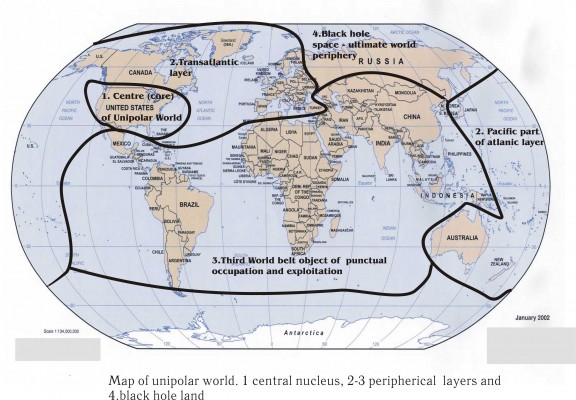
CLICK IMAGE TO EXPAND (Eurazia.org)
The model of unipolar world. The nucleus and layers (2-3). Russia-Eurasia conceived as “black hole”
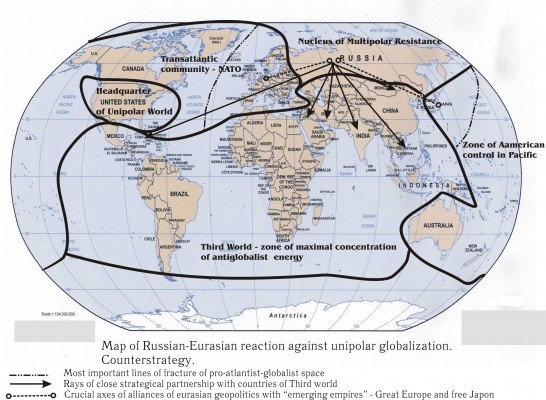
The counter-strategy. The eurasian geopolitical activity of construction of multipolar world.
The structure of multipolar world. The eurasian vision of future.
Thus, it is already visible to us that there are at least two possible methods of application of a 4PT for the US. The first would involve a rather inorganic process of placing the European and Eurasian experience into the mold of the US. The second, however, would involve taking the core methodological framework of a 4PT, but creating it organically from within the US’s own political culture and politico-philosophic history. First, this would have to take place at the academic level, where these ideas would gain traction, and become then the framework by which alternative media pundits and activists took their inspiration. The US needs its own figures to communicate ideas regarding its own radical transformation.
This second proposal seems the most prudent, because this is not only based upon a more popular approach to US political culture, but also one which promotes “isolationism” and “non-interventionism”. This non-interventionism is not only characteristic of the core US popular sentiment, and is closest to its own formally described philosophical origins, but also sets the right framework for disassembling the Atlanticist Empire in practical terms as well. Simultaneously, it would mean a smaller US with different borders.
Outside of these two proposals or possible methods of application of a 4PT for the US, which will be explored later on in this paper, is the present and existential problem of the US as a viable entity. The need in the US for a new political theory and a new conception of itself will be driven not in the abstract, but by very real, very tangible issues confronting the US project.
To summarize then, there are possibilities on the level of theory for the development of a 4PT in the US, and there is an economic and ethno-demographic requirement for one as well. Even to confine ourselves to the economic and ethno-demographic problems in the US, we can see that the US suffers from a crisis in legitimacy. Understanding this, and the potential for further research in this area, will allow us to better understand how the US Empire can be disassembled and on what basis a 4PT can be introduced.
A Crisis in Legitimacy
In practical terms, the US is suffering a crisis in legitimacy internally, and cannot manage to create a coherent or sustainable economic policy. In our past work on this subject (cited as “[2]” below), we gave statistics relating to the rising cost of food and housing, which are critical objective analytic indicators of potential for unrest and major political and social disruption.
Since that time, Reuters news agency conducted a scientific poll which found that about 25% or one in four Americans want their state to leave the US. This figure is fueled by a number of facts which are only projected to grow in the coming decades. At a certain point, especially if this idea is vigorously promoted, it may surpass the 50% threshold. Following a similar legal framework which has hitherto justified the secession of Kosovo and Crimea, (though the former is highly questionable), we may proceed to invoke the same precedent in the US. Furthermore, contained within the US framing documents of the US, including the US Constitution and the Federalist (as well as Anti-Federalist) Papers, an internally coherent legal framework can also be derived.
This scientific poll conducted in September of this year (2014) used a sample size of over 9000, which is 900% of the sample size required for a scientific poll of this kind, resulting in a margin of error of only +/- 1.2%, and asked the following question: [1]
“Do you support or oppose the idea of your state peacefully withdrawing from the United States of America and the federal government?”
The results were, for US analysts and lawmakers, startling. Below is the breakdown of the results
[Figure 1] CLICK ON IMAGE TO SEE RESULTS IN MORE DETAIL
There are reasons which can help to explain this kind of result, which we will explore in brief. By and large, they relate to the nature of the ‘American People’. Oswald Spengler adequately described a critical feature of Anglo-Saxon political economy, being that Great Britain is primarily a multi-ethnic society (Angles, Normans, Saxons, Picts, Welsh, Scots, Jutes, etc.) which is internally organized and self defined by socioeconomic class. This observation was made in relation to his critique of the Marxian analysis of class, which he saw as being overly based in his observations of society in Great Britain and the British isles. Nevertheless, to the extent that this was arguably true of Great Britain and the British Isles, it is inarguably the case of the US which is comprised of people extraordinarily less related and less connected by geography and time; such as Latinos, African Americans, Arab middle-easterners, Anglo-Saxons, Western Europeans, Slavs, Native Americans, east Asians, and south-east Asians. Furthermore, within these larger groupings are contained national groups who in fact may have more animosity towards each other than they do to others outside of these larger groups; for example, Salvadorians and Mexicans, or Chinese and Japanese.
The United States has therefore not a ‘people’ (ethnos or ‘narod’), it is not a ‘nation’ bound by long standing historical, linguistic, cultural, familial, or experiential ties. It may be a in a process of ethnogenesis, but success in that project will depend on phenomenon which will likely take place over a length of time longer than the near-term political structures are able to accommodate. This latter question is one that must be considered in exploring the former. The fragile nature of the US ‘state’, and its hegemony within its continental sphere is predicated upon a number of technological devices, that promote a kind of cultural or sociologic conformity, whose lifespans are nearing an end. Specifically, the eventual obsolescence of ‘old media’ and its continual replacement with ‘new media’ is one of the driving forces of change, which sees an end to the hitherto success of the hegemonic myth of a mono-culture, within the present-day borders of the US.
So, in looking at ethnicity and that ‘non-people’ nature of the US population (it is a population, not a people), we must also look at class. The US is not a ‘national’ society, but a ‘class’ society which uses extraordinary amounts of jingoism to masquerade as a ‘national’ society. The kind of struggle waged against the oligarchy in the US has primarily been successful (in a limited sense) when it was a class struggle. This was when workers, farmers, small land-owners, and small businessmen, have found common cause in a popular class struggle – across ‘ethnic and national’ lines, against the oligarchy. Thus racism has historically been used by the US oligarchy as a means to frustrate a kind of class struggle against it.
The US is not a ‘national’ society, but a ‘class’ society which uses extraordinary amounts of jingoism to masquerade as a ‘national’ society…
To help see that antipathy towards the United States and the federal government is connected to a potential class struggle, we can look at the second graph from the Reuters study. In it we see a direct correlation between class and support for disintegration of the US and opposition to the federal government.
It is also inarguable that the economic trends in the US are seeing an upward redistribution of wealth, away from the shrinking middle-class, leading to further polarization and instability. This is quite dangerous when combined with other factors, such as rising food costs and decreasing political legitimacy. This must be understood in relation to proven models of successfully charting instability, using the very same methods of analysis which the US relied on, somewhat successfully, to destabilize North-African and Middle-east countries during the so-called Arab Spring.
In our paper titled “Towards a New American Revolution”, we explained: “But history proves that there is only so much that people can take, before they rise up. In objective terms, an observed pattern indicates that uprisings are all but inevitable when food prices exceed the nominal FAO-UN index figure of 210 when combined with a government with decreased legitimacy in the public eye [2]. This threshold figure was first crossed in February of 2008, which directly led to the Arab Spring ‘uprisings’ in 2010. This high index figure was in all ways engineered: after the collapse of the Housing bubble in 2007, the massive and endless bailouts starting with QE-1 were used to generate a stock market bubble.” [2]
“Besides creating an important ideological fiction of a ‘rebounding stock market’, specifically perishable goods commodities futures markets were targeted for cornering. This resulted in an engineered spike in grain prices. Governments were forced to rebalance their internal economies in order to subsidize and correct for this sudden change. This is also no small part of the ‘sovereign debt’ crises in the EU periphery states, the PIIGS nations – Portugal, Ireland, Italy, Greece, Spain – which continue to experience a sustained condition of social upheaval which has been branded in different ways by various participants, pundits, and analysts (indignados, 99%/Occupy, etc.) [3]”
Indeed, in the face of a rising FAO index (food price index), and upward redistribution of wealth, we have seen a considerable increase in the number of those in the US population who receive direct government assistance to purchase basic food. We can see that this number is at about 50 million persons. That is despite several decades of austerity legislation which makes it more difficult to qualify for said assistance.
The following graph will show that after the QE1 ‘bailout’ of 2008, GDP grew, yet household earnings dropped significantly, demonstrating an upward redistribution. Not only is there a sharp shift, but it is rapid. The number of homeless and unemployed families in the US stands at an all time high, not only in numbers, but per capita as well.
To further illustrate this point, we ought to look at a race/ethnic demographic map of the US. While the largest three or four US cities are relatively ‘integrated bastions of multiculturalism’, the real demographic figures by states of residence are clearly visible along ethnic and/or racial lines. Taken in context with the poll regarding secession, we can begin to see the framework of more loose representation of the various regions embodying the states of the present-day United States. This map shows where the majority of African-Americans are concentrated. Session here would result in a confederation with a distinctly ‘African-American’ cultural essence.
The recent wave of seemingly racially charged police killings of African-American suspects, has further highlighted long standing racial antagonisms in the US. The federal government in DC continues to impose its highly centralized rule under the spectacle of a federal republic, and a new generation of black youths are becoming politicized and made more militant under these norms. In a secessionist scenario, the area shown in the map below would be in a position to ‘reset’ race relations, and solve any number of related problems. Furthermore, a conception of a ‘New South’ can be created, one which also takes into consideration some of the ‘confederate’ ideas of a new generation of southern whites who are themselves not racist per se, i.e. oppose supremacism, but who also view sympathetically the secessionist CSA of the 1860’s before and during the US Civil War. Economically, it would be most viable if it were able to integrate more closely with other actors in the Caribbean who also are of African descent, and to which the African-American intellectual elites and academics have already made significant political connections with, dating back to at least the middle of the last century. As a post-US and anti-imperialist state, it would also be able to integrate further with Cuba, and form links also with Afro-Brazilians.
A note should be made here, because in the state of Florida we would expect to find a high number of people identifying as both black and Hispanic (of Caribbean origin), and are therefore not included in this demographic map.
The next map shows the same, with the same consequences, for so-called ‘non-white Hispanics’ and ‘Latinos’. In post mid-century political discourse, this region is referred to as ‘Aztlan’.
With the exception of Idaho, Wyoming, Nebraska, and Washington, the states shown below correspond to the territories of Mexico prior to the Mexican-American war of 1846. Some legal basis for a secession of this ‘Aztlan’ territory or region can be made from the manner by which the treaty which formalized the peace process following the war – The Treaty of Guadalupe Hidalgo – has been abrogated. These demographic trends are universally agreed to continue. In the near future, the south-west will be majority latino/hispanic. While it is not on the agenda, even a total closing of the border cannot change this eventuality due to birth rates.
When looking at these two maps together, several conclusions may come instantly to mind. It becomes clear that what will be left of the ‘US’ may be in the remaining area. What has not been discussed is the issue of Native American sovereignty. Native American claims on a legal basis are likely to be larger than the area indicated in the below Figure 7. However, it is important to understand that these reservations already exist as sovereign nations, which have accords with the US federal government. The tribes which live on these reservations are sovereign political entities, with their own police force and institutions for managing natural resources and other social needs. While they are largely impoverished, this is a result of conditions largely imposed upon them, in a manner similar to the colonial or neo-colonial Atlanticist model, and are not indicative of their innate abilities as a people (or ‘first peoples’).
When looking at ‘Native Americans’ or ‘first peoples’, there, in the US culture, is an all around sense of sympathy. It is a commonly held view that Native Americans have not had justice, and that the things which happened to them, and continue to happen, are wrongs which still must be righted. Here it will be important to continue to work with a new generation of tribal leaders who want to increase their people’s right to self determination in all spheres, sovereignty, and autonomy.
Conclusively then, we can now see where the areas of promising research and work on the subject are. The US faces a crisis in legitimacy, and the manner in which it is paradigmatically incapable of understanding the roots of these problems also creates certain opportunities. When we look at the number of people in the US who would like to have their state leave the US, and we look as well at the ethnic or racial demographic reality, the stark contradictions which characterize this aspect of the US alone are easily discernable.
The Organic Process of a 4PT in the United States in Academia
When we understand a ‘Fourth Political Theory’, we understand the previous three – Liberalism, Socialism, and Fascism. Formally, the United States, unlike Europe and Eurasia, has only experienced the first. Socialism and Fascism are formally alien and European or Eurasian phenomenon (and ideas), which the US in formal terms cannot be said to have ever passed through. Upon more close examination, however, we can uncover the following: the US has maintained a formal framework within Liberalism, but there is more than this.
Indeed it still holds liberalism’s primary values such as individualism/atomization, commercialism/materialism, and of course the strange combination of moral or ethical universalism and relativism (together). At the same time, its proponents and official advisors at the academic level, in each generation, were influenced in part by the developments occurring in Europe and Eurasia during the 19th and 20th century. Bonapartism had an influence on neo-federalism and neo-federalist drift; jumping forward a century, the rise of Socialism and Fascism also influenced (and indeed were influenced by) the concepts behind mass social organization and the related technical forms of mechanical and sociologic analysis (e.g Weber, Marx, et al), useful to the maintenance and expansion of the Atlanticist project. This was seen in projects like Roosevelt’s Public Works Administration act of 1933, and the New Deal in general.
The 3PT in many ways came from a study of the US economy at the start of the Taylorist or Fordist period. Works like ‘The Corporate Ideal in the Liberal State:1900-1918’ by Weinstein also provide a coherent reference for understanding the incorporation or interpretation of Socialism and Fascism into an otherwise commonplace discourse on social organization and social progress. These occurred after the rise of Socialism (2PT) and before the rise of Fascism (3PT).
In that light, ‘progressivism’ from the same period as is covered by Weinstein’s work, can be seen as the American pragmatic metabolization of those deficiently modernist elements of Socialism and Fascism. Simultaneously, they also were a continuation of the ‘American System’ figures like Henry Clay and Jefferson Davis. ‘Progressive’ still to this day is the label which both radical liberals (left liberals) and liberal-communists (socialists, ‘Marxians’, etc.) use to describe themselves within the obfuscating mandates of politeness within the Anglosphere’s political discourse.
In the US there are vulgarized forms of a nascent ‘Fourth Political Theory’ in academia, based in post-modernism, critical theory, and post-structuralism, already gaining prominence for some decades, coming to dominate the departments of philosophy at any number of the most ranked and prestigious universities. These have in some areas either surpassed or consumed the ‘analytic’ school.
It also acts as a kind of semi-affirmative response to Heidegger, through figures such as Marcuse and Camus (i.e liberal-‘communist’ existentialism). Other students are introduced to Heidegger through Arendt. But at any rate, while problematic, it also demonstrates the framework for a common language and universe of ideas and concepts which, with the right efforts and direction, can be seen as a fertile ground for a more properly understood ‘Fourth Political Theory’. The ideas of Heidegger, as well as Husserl, Hölderlin (et al), are vigorously approached, even where in many sectors they are poorly defined or understood, and the views of Adorno and Marcuse are valued over Heidegger.
What does dominate, however, much of the US vulgar though nascent ‘4PT’ is a liberal (i.e relativist) Nietzschean ‘transvaluation of all values’. While wrapped in liberal conceptions, there remains in sections of this milieu some very fertile ground. It is here that among US graduate students, young professors, TA’s, and lecturers – as opposed to mainly vetted and tenured professors – who have encountered A. Dugin and who already have begun to see him as a figure deserving attention. Because this represents the culmination of Continental European philosophy which was seen as the most appropriate way to approach a Cold-War mandated critique of Marxism, we now have in this period an unintended consequence, whereby mainstream institutions promoted the study of the Continental school at the expense of the Anglo Analytic school.
Presently there is simply a one party system with no opposition, and no mechanism for oppositional politics to positively influence the political outcome.
Simultaneously, Western Marxism was also, and in some areas is still, taught at the highest levels in US academia. Over the last several decades, many among the Marxians and Structuralists have become Post-Marxians and Post-Structuralists. Others have become ‘left-Nietzscheans’ in the image of Foucault, while others still have gravitated towards Soviet Marxism, and have become or remained “unreconstructed Marxists”. This next connection may be somewhat difficult for those not familiar with US academic and intellectualism. There was something of a flowering of Marxist and Structuralist academia and new interest which began vigorously in the 1960’s. At the same time that these pseudo-Leninists, Anarchists, etc. were nominally dedicated to a materialist view of history, epistemology, and ontology, there was also something else going on beneath the surface. There was also a significant increase in interest of the same milieus in Buddhism, Hinduism, “eastern philosophy”, Islam, and New Age. Based on their anti-liberalism and anti-imperialism, they were drawn to a center of resistance which appeared to be led either by the USSR or China. Simultaneously they were drawn to ideas which sought to redefine man’s relationship with modernity and consumerism, and draw up a new interest in mysticism and esoterica. So in a number of ways this is and was similar to the milieus and circles which existed in Weimar Germany that gave rise to popular National Socialism; a simultaneous interest in questions like the mysteries surrounding human origin and human spiritual potential with a view towards the East, with an anti-capitalist and pro-socialist view of political-economy.
Furthermore, the influence of Marxism and the related ‘conflict theory’ in the field of sociology cannot be overstated.
In many ways this was a product of the pro-market bend of the ‘Open Society’ initiative, which came to be dominated by Chicago school thinkers and writers. Karl Popper warned that it would be necessary to include liberal-socialist economic and political thinkers into this ‘Open Society’ as part of a broad liberal project, to include the US left and those associated with the Socialist (2nd) International. His warning was not heeded, and this contributed in part to the left/right polarization of academia, and helped to push those critical of market economics into the position they are today. This, in its own way, today can be seen favorably in that it will contribute to the conditions that will make a 4PT academic pole in the US possible.
While taking their ideas primarily from Continental philosophy, and as such being deeply immersed in Hegelianism and Existentialism, these are organically ‘American’ thinkers who already have publication networks and peer review journals, tenured positions within academia, with some considerable influence.
Entirely separately, and in a different direction, are the Analytic and Liberal philosophic schools. With some exceptions, such as communitarianism and analytic Marxism – both of which challenge Rawls’ liberalism while still being modern – these are essentially liberal. Nevertheless, in this realm we encounter the primary Epicureanism which characterizes much of the foundational thinking in a truly US philosophy. There is less here that is obviously workable or compatible with developing a 4PT pole of attraction, but this should not be overlooked. Primarily because the core of US conservatism lies here, and in order to transcend the left/right paradigm means looking at where these ideas fit – from liberalism – and how these liberal ideas of the framers of the US constitution can be directed against the Atlanticist project. After all, there are any number of ideas contained here which are really not compatible with the Atlanticist project. The ‘universal’ liberalism is conceptually contained, of course, in the foundational discourse of the US project.
At the same time, concepts from the early 19th century, in J.S Mill such as ‘Experiments in Living’ can be seen as political-philosophical concepts which promoted federalism (today, confederalism) as opposed to a unitary state. These are anti-universal in nature, or rather, what is universal is ‘to each their own’. By ‘experiments’ Mill means really two things – heterogeneity or diversity, and independence or local sovereignty. Mill saw this valuable not simply in the liberal individual sense; giving rise to entrepreneurship, individual initiative and ingenuity, but between various towns, communities, and states. Anathema to him would be modern liberal universalism, which really puts an end to global diversity in living. Later, Mill would take more socialist views on economics, seeing the limitations of market economics when placed upon societies of scale.
The ideas of Mill, as well as Bentham and Locke, as well as of course Jefferson, (et al), really are not only compatible with a multi-polar vision of the world, but also hold the US accountable by the very same ideas and ideals which it claims to hold dear. These dig into liberal and its offshoot, libertarian thought, and can form of anti-imperial and multi-polar resistance to the Atlanticist project.
These ideas form some of the foundations of left-liberal, right-liberal, and libertarian thought today, which in many ways are alienated from the US radical left. Though both frameworks represent modernity – one bordering on pre-modern, the other bordering on post-modern – they are about equal in terms of adherents in the US, and both have significant influence on US political culture outside of what is represented in the mainstream, old media.
Taken together, what we have are the pieces required to forge a significant 4PT pole within US academia.
The political problem is that the US educational system is politically controlled by the dominant powers. So, it may be necessary to take a more radical course if it proves impossible to successfully penetrate the bureaucratic and political barriers. We have, however, some precedents to work from.
Contemporarily, we can see that Russia and Iran had been frustrated by their efforts to receive fair coverage in the news-media within the US. Rather than push against this wall, they began initiatives – Russia Today and Press TV, respectively – to create English language news channels which both air on live television within the US. Similarly, in the past, in academia, we saw how the Frankfurt school was relocated out of Germany, and brought to the US at Columbia University once political conditions made their work too difficult.
Likewise, once (or, preventing this, before) a foothold can be established by a core group of supportive academics, a ‘NYU’ School or ‘UC’ School can be established, for example, in Belgrade, Tehran, or Moscow, with dissident professors. They would publish and hold conferences in English and would be American ex-patriots who form a nucleus of academic resistance. Their views, lectures, books, and articles, would be the focus of English language information distributed and projected across all mediums of new media.
Basic Elements which frame the Present US Discourse
In the practical political sphere within the US, there is not a struggle between liberalism and something else, but between two or three visions of liberalism. At the same time, there are kernels of something post-liberal and anti-modern within two of these. Presently there is simply a one party system with no opposition, and no mechanism for oppositional politics to positively influence the political outcome. This is the political system which now corresponds to a liberal form of capitalism which ignores or pretends to ignore sociologic formulae, and proceeds to give (or burden) all responsibility for the outcome of a person’s life on the ‘individual’. Politically, this one party has two faces – one Democrat, the other Republican. On the fringes of these parties however, both on the radical anti-capitalist ‘left’, and on the paleo-conservative, libertarian, and constitutionalist ‘right’, there is potential for a fertile ground as well. The area of mutual agreement which these two fringes have, which are otherwise apparently at odds, has grown rapidly and enlarged considerably over the last fifteen years. If we were to date this, the ”9-11” phenomenon might be seen as a starting point of this growth and enlargement of the agreement zone, if depicted on a Venn diagram.
It is, of course something to consider that ‘left’ and ‘right’ within the Anglosphere have a somewhat different meaning than either what they have in Eurasia, or what they had within the Anglosphere in the middle of the last century. These areas of agreement between ‘left’ and ‘right’ relate to the power of big businesses (corporations), the never ending wars (military imperialism and military industrial complex), the decline of living conditions (collapse of the middle class), and the erasure of constitutional rights in areas of speech, political association, privacy, in addition to the malignant growth of a consumerist and celebrity oriented culture.
There is another sphere of problems which both are in agreement about, but use entirely different terminology to explain, and assign different causes and solution to said problems. But this ought not be a source of frustration, but yet one that would require further work. These relate to the role of markets and even as to what the very purpose of society is. The radical left in the US has a conception of what the purpose of society is, which is closer to how Eurasianists view the question, in that it contains a criticism of liberalism and modernity.
There really is no 3PT pole in the US whatsoever, not beyond some exoticist following confined to virtual spaces, and with no influence at all on the political discourse. Europeans and Eurasianists often make the mistake of thinking there is one, because there are some racist or segregationist type groups, but these are purely identity based. Their view of society and economics is purely liberal in every sense. They are liberal racists. Their fascination with the Third Reich, in such cases, is based primarily upon television documentaries which present perspectives not only distorted in content, but fixated upon symbolism, military hardware as it relates to this, and aesthetics in general. Their numbers are extremely small, and the lack of academics, intellectuals, supporters, popular support, or even individuals capable of organizing has been well known and documented for decades. Anyone familiar with, for instance, the National Renaissance Party, is abundantly clear about the prospects of this sort of initiative
Furthermore, it does not behoove a European or Eurasian 4PT supporter to make political alliance with this irrelevant milieu. From a public relations perspective, this can only result in extreme marginalization, and a total inability to ever gain real or meaningful traction. It also makes unworkable the tacit alliance with Latin American ‘National Communism’ such as Bolivarianism. The issues in the US of race, or even immigration, are not similar enough to its European version to warrant a similar approach. African Americans are not immigrants to the US, and were brought against their will, only to be subjected to any number of well documented conditions. The historic Anglo enforcers of white rule in the US are not indigenous to the US, and are not ‘defending’ the land from ‘foreigners’. The Native Americans and Mexicans, however, are the indigenous people. This obvious fact is not lost upon anyone seriously involved on any level in the US in bringing down the US Empire. This should not be misinterpreted as anything else, however. Given the mobility of the middle class in terms of choosing where to live, and given that in the US culture it is the norm to settle in a place other than where one is born or has family, there are few reasons to live in one place as opposed to another.
What we find that people choose to live in communities and parts of towns where the people bear a phenotypic resemblance to themselves. Given the phenomenon of ‘white flight’ in the 1960’s, where whites moved from cities into suburban areas as well as new developments and towns, combined with self-segregation, we are presented with reasons why in fact ‘White Nationalism’ (understood separately from 3P) has never taken hold in the US: people self-selected their neighbors, and the pressures are not really present.
Popular Resistance to the Atlanticist Project – Americans are Socialists and Libertarians
The main popular poles of resistance in the US are, on the radical ‘left’ – not to be confused with liberal left intelligentsia and gate-keepers; rather we look at the hard-line communists and to a lesser extent socialists and anarchists; and on the ‘right’ it is the Libertarians and Constitutionalists, and to a lesser extent the paleo-conservatives and the militia-movement (which are respectively related to the former two). Both of these categories each represent many tens of millions of individuals.
Quantifiable evidence for both of these claims rests in this: In 2011 a scientific poll was conducted by the reputable Rasmussen polling agency [3], which found that 11% of all ‘Americans’ believed this:
” 11% Say Communism Better Than U.S. System of Politics and Economics”.
As 80% of ‘Americans’ are adults in a population of 320 million, the number supporting Communism today stands at about 26.5 million. Another reputable scientific polling agency, Gallup, reported in 2010 that 36% (of an adult population), or 92 million, of all Americans had a positive view of Socialism, from which we can infer, would otherwise identify as ‘Socialists’ [4].
On the libertarian end, we are also able to quantify. Ron Paul ran on a purely Libertarian platform but as a Republican in the 2012 primaries, and came in fourth place, receiving about 2.1 million votes [5]. This process was widely understood to be have been rigged against Paul, and in a manner not too different from previous electoral riggings in the US, may have in fact been robbed. The Cato Institute however sheds some more light on this question with their study. They find that about a minimum of 14% of ‘Americans’ are Libertarian, with as many as 44% [6]. That gives us between roughly 30 million and 110 million, out of the universe of US adults, being 256 million.
What this means is that the formalized political system, represented nominally by Democrats on the center-left and Republicans on the center-right (1) have a monopoly on a political process that actually does not represent the fundamentally socialist and libertarian nature of the US population. Communists and socialists are largely compelled to vote for Democrats, and Libertarians and Constitutionalists are largely compelled to vote for Republicans. Separately, Anglo culture focuses on a passive aggressive form of politeness, and in public spaces it is rare for Americans to state their real views (or have these published by the gatekeepers), under fear of passive judgment and concealed ostracization. Privately they will call themselves communists/socialists or libertarians/constitutionalists, but in public you will hear the terms, respectively, ‘progressive’ and ‘conservative’, even though they know they are essentially concealing their real view.
How we can interpret this data, is another matter, which will require further research. To wit, a majority of socialists and libertarians at present have a prevailing modernist and liberal worldview. Nevertheless, what we can understand better is what we are working with and working from. A 4PT approach in the US may begin with a Venn diagram of things which are common to 4PT and Socialism, and 4PT and Libertarianism. Furthermore, the anti-imperialist angle and the deconstruction of the Atlanticist Empire are by and large shared values among both libertarians and socialists.
On the outset, we can already begin to see a sketch of the sort of memetic campaign that would be required to popularize 4PT ideas within the US. Naturally, a 4PT permutation from within the US would have to entirely reconsider Liberalism, and ultimately do away with most of its features. At the same time, some of the views and values of ‘Americans’, and even a few root concepts in Liberalism, are salvageable. Thus, we may see in a post-Liberal and post-Atlanticist US something very loosely analogous in the US to how Russia has today metabolized the Soviet experience.
The United States may need to deconstruct, and if it ever re-establishes as a power, that it is a land-power or continental power. A new covenant or contract with its old parts would need to be made, based on a different understanding of itself, its past, and the various ‘nations’ living in its different former parts. The process of US ethnogenesis is likely to be a long one, and it is more likely that the political project will fail, leading to contraction, centuries before ethnogenesis can take place. Given the unknowable future of technology and other developments, it is questionable if this ethnogenesis will ever take place. What seems more certain to be on the near-term agenda, is a deconstructed United States which will see a conversion into distinct zones better suited to the majority populations of each part. The forms this takes, naturally, are still unclear, whether they will nominally call themselves the US or not is not knowable, nor is it entirely fundamental.
Divisions of race and class in the US, combined with a liberal ideology which can no longer provide meaning, coupled with a sinking economic model, means that a significant change is on the horizon. These changes create the possibility for a Fourth Political Theory of some kind to take the place of the late Liberal theory which is failing today.
ABOUT THE AUTHOR
 Joaquin Flores, is a geostrategist and founder and director of the Center for Syncretic Studies (Belgrade).
Joaquin Flores, is a geostrategist and founder and director of the Center for Syncretic Studies (Belgrade).
The Center for Syncretic Studies aims to:
Popularize knowledge about social and ideological movements which are existing and developing alongside and within the ‘Globalization process’ promoted by the Atlanticists; disseminate knowledge about social and ideological movements which are arising in response to neo-liberalism and late capitalism
Provide a public venue for critical analysis of contemporary globalization and liberalism/neo-liberalism; provide a resource for critical analysis and re-evaluation of past, syncretic, and new ideological and geopolitical schools
Sustain a public hub for programmatic discussions about the present state of syncretic and new ideological movements and work, act as a think-tank for syncretic and new ideological frameworks to promote political and geopolitical alternatives
Be a public forum internationally that supports dialogue between historically adverse movements and organisations, intellectuals and non-governmental organisations across the political and ideological landscape.
Perform regular geopolitical and geostrategic systems analysis summary and forecasting.
NOTES
(1) Technically, and in practice, both Republicans and Democrats are on the center-right part of the spectrum, with the Republicans more vocally so, while also comprising and defending extreme right positions. Occasional Democratic party rhetoric honoring left ideas and positions is merely posturing to maintain the illusion of some choice in the US political ambit. By its nature, the entire corporatist state is deeply conservative. —Eds.
References—
1. http://blogs.reuters.com/jamesrgaines/2014/09/19/one-in-four-americans-want-their-state-to-secede-from-the-u-s-but-why/
2. http://www.4pt.su/en/content/4pt-prospects
3.http://www.rasmussenreports.com/public_content/politics/general_politics/march_2011/11_say_communism_better_than_u_s_system_of_politics_and_economics
4. http://www.gallup.com/poll/125645/socialism-viewed-positively-americans.aspx
5. http://www.thegreenpapers.com/P12/R
6. http://www.cato.org/blog/how-many-libertarian-voters-are-there



